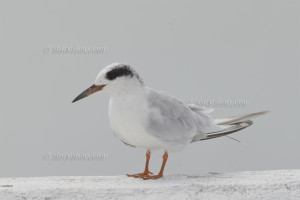 Terns in general are excellent fliers, which may, from time to time, appear as vagrants outside of their home range. Forster’s Tern, Sterna forsteri, are no exception in that. Only some days ago, a Forster’s Tern was found on the coast of Ireland. An adult winter Forster’s Tern could be observed at Corronroo along with Common Loon (Gavia immer), 3 Little Egret (Egretta garzetta), Long-tailed Ducks (Clangula hyemalis), some Red-breasted Merganser (Mergus serrator), Northern Lapwing (Vanellus vanellus), 2 Spotted Redshank (Tringa erythropus), 3 adults and 1 first-winter Mediterranean Gull (Ichthyaetus melanocephalus) or (Larus melanocephalus) and 1 second-winter Little Gull (Hydrocoloeus minutus). This would have been an excellent selection of birds for a continental birding day in the middle of wintertime. Other Forster’s Terns could be found in Galway on Mutton Island, at Nimmo’s Pier, at Doorus and off Newtownlynch Pier. All observations were made between mid December 2014 and beginning of January 2015.
Terns in general are excellent fliers, which may, from time to time, appear as vagrants outside of their home range. Forster’s Tern, Sterna forsteri, are no exception in that. Only some days ago, a Forster’s Tern was found on the coast of Ireland. An adult winter Forster’s Tern could be observed at Corronroo along with Common Loon (Gavia immer), 3 Little Egret (Egretta garzetta), Long-tailed Ducks (Clangula hyemalis), some Red-breasted Merganser (Mergus serrator), Northern Lapwing (Vanellus vanellus), 2 Spotted Redshank (Tringa erythropus), 3 adults and 1 first-winter Mediterranean Gull (Ichthyaetus melanocephalus) or (Larus melanocephalus) and 1 second-winter Little Gull (Hydrocoloeus minutus). This would have been an excellent selection of birds for a continental birding day in the middle of wintertime. Other Forster’s Terns could be found in Galway on Mutton Island, at Nimmo’s Pier, at Doorus and off Newtownlynch Pier. All observations were made between mid December 2014 and beginning of January 2015.
In the Western Palaearctic the first Forster’s Tern, probably an adult specimen, was taken on 22nd October 1959 in Iceland. Since 1980, when the next was seen in Britain, there is a considerable increase in observations which probably is caused mainly by the growing awareness of observers, but perhaps also by a northward spread of Forster’s Tern on the American Atlantic coast. Until 1986, 12 birds were reported from Britain and another 5 from Ireland. The only Forster’s Tern for Continental Europe was an adult observed on 2nd and 3rd November 1986 in the Netherlands
In non-breeding plumage, the equally sized Common Tern (Sterna hirundo), Arctic Tern (Sterna paradisaea) and Roseate Tern (Sterna dougallii) are easily distinguishable by markedly other head patterns and are generally less similar to Forster’s Tern than the Sandwich Tern. First-winter Forster’s Terns show dark tail tips, a more extensive and less demarcated black face pattern and blackish wing tips.
With some comparative experience, Forster’s Terns are unmistakable in non-breeding plumage. It is said, that in eastern Atlantic Forster’s Terns could be overlooked as Sandwich Tern. Also on other sites along the western coast of Europe and Great Britain, you might have chances to see (and compare) these beautiful Tern species.
As in the case of the two small terns of the genus Sternula, Least Tern (Sterna antillarum) and Little Tern, Sternula or Sterna albifrons, whitish Terns of the genus Sterna with basically a red bill are not so easy to separate in identification at first hand. Thus the images in the gallery of Forster’s Tern shot at Chincoteague National Wildlife Refuge, Virginia/ USA might help to identify. The Forster’s Tern is a Nearctic species with a widespread breeding distribution throughout temperate North America, where it is mainly found in fresh and salt marshes. In winter the habits of Forster’s Terns are more maritime, when the birds can be found from California and Virginia in the North to Panama and to the West Indies in the South.
In order to meet the growing demand for top images of the rarer species of Palearctic Bird-lens.com has specifically made trips to remote places in Europe but also to other parts of the world. This to do everything to ensure excellent photos of the birds of the Western Palearctic. The yield of pictures also of rare Western Palearctic birds is very good. The beautiful pictures that you see in the blog is just first impressions of what you will find behind the tab “Picture- Store” very soon are. Just give a notice if you need a picture of a bird before the new images are online.